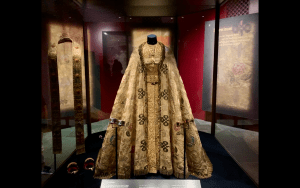This weekend, I went to the Tower of London and viewed the crown jewels on display there. The experience was enjoyable, and the display was definitely beautiful and worth seeing. The exhibit was very interesting and well done.
As was expected, the line to see the crown jewels was quite long, but the the exhibit was set up so that no one was standing still for too long. In fact, it was not even possible to stand around the crown jewels, because a conveyor belt forced viewers to keep moving. The security for the jewels is extensive. (In fact, they would not even let me take a picture of them, which is why I have included a picture of other clothing from the Royal Collection, including the sash of current Queen Elizabeth II, displayed on the left). Clearly, the museum is very worried about theft, which is understandable of course, since the most expensive diamond in the world currently resides within its basement. However, this is quite ironic as well, since this jewel, the Koh-i-Noor diamond, was obtained by the British through less-than-honest means.
The Koh-i-Noor diamond is currently contested by several different nations, including, India, Pakistan, and the Taliban in Afghanistan. The name means “Mountain of Light,” which is fitting for the over 100 carat diamond. According to “The True Story of the Koh-i-Noor Diamond—And Why the British Won’t Give It Back” by Lorraine Boissoneault, the diamond has a deep history from its founding in India thousands of years ago, possessed of countless rulers, and finally in the hands of a Persian child-king. From this 10-year-old boy, the British quite literally took candy from a baby when they forced him to give up the diamond and his rule in exchange for his mother’s life.
The story of the Koh-i-Noor diamond is not very well-known, and the Tower of London exhibit, although explaining the history of many of its items, does not disclose the provenance of the diamond. In fact, the provenance was not listed for any of the jewels. Even the Tower’s website, which gives a brief history of each item, only describes the acquisition of the Koh-i-Noor as a condition of a treaty, rather than what exactly that treaty entailed.
The Koh-i-Noor diamond is far from being the only contested item in Britain’s possession. The famous Elgin Marbles from Greece, as well as a moa from Rapa Nui, are also wanted in their homelands. The British do not typically acknowledge their imperial history in these exhibits like the Tower of London and the British Museum. Instead, Indians, Greeks, Polynesians, and countless other peoples need to come to Britain to see their own artifacts. (Some of which, like the Koh-i-Noor, are not on display for free, so they must physically pay to see their own items as well).
While returning stolen artifacts is not always so simple, the collective blindness that the British exhibit toward their own imperial conquest is pretty alarming. The British claim that the British Empire no longer exists, and yet the British Museum makes millions of dollars each year from these stolen artifacts. Even the Museum itself is a symbol of imperial conquest (the style of the building stolen from the Greeks, among other things within it). The British Empire is still evident, even if the territories are no longer within its political control.


